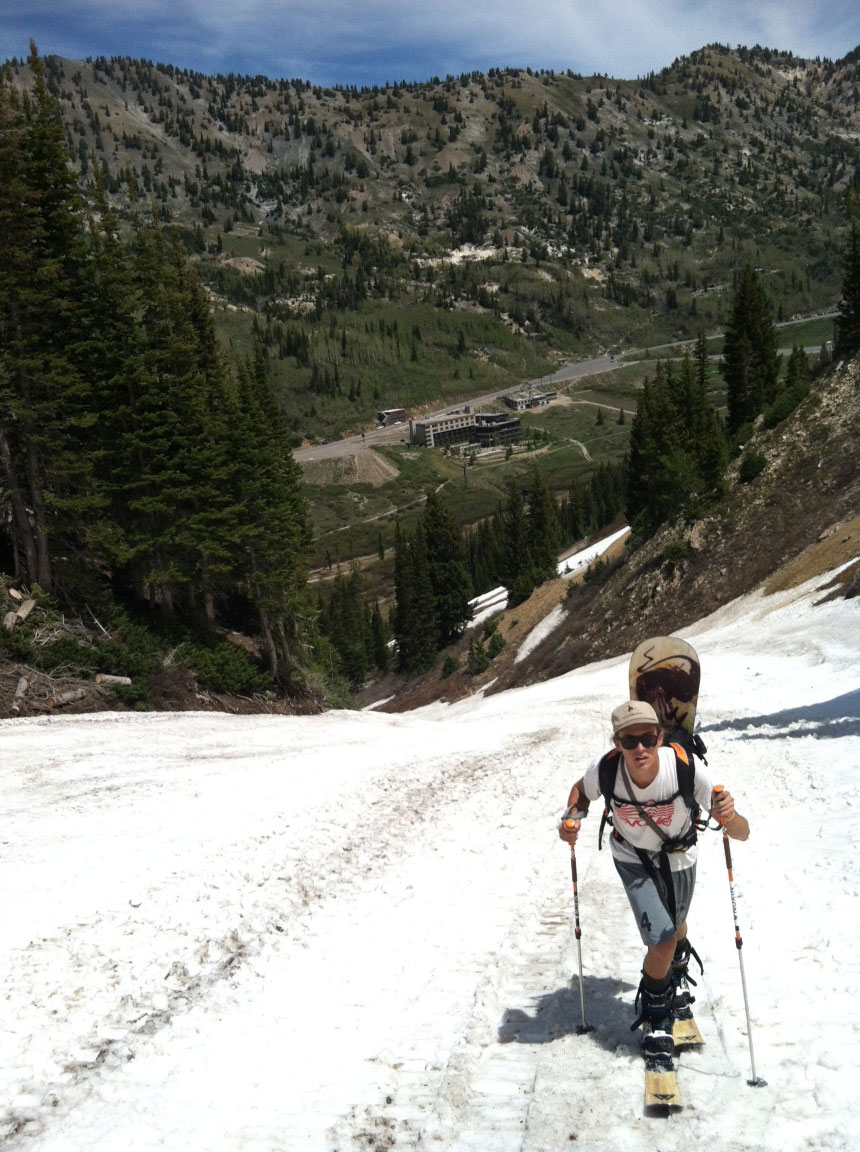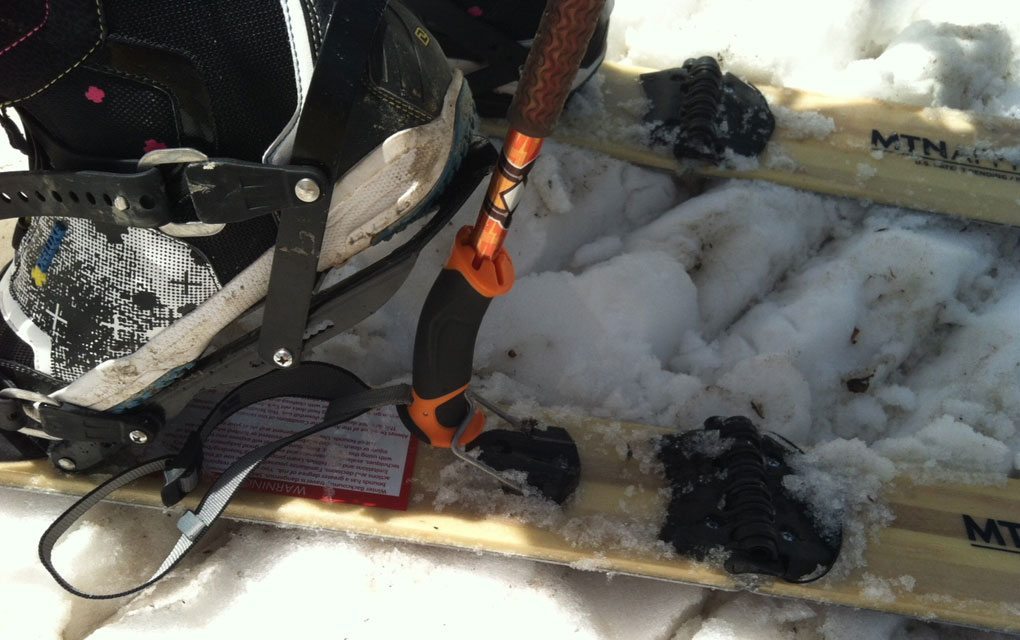The first pitch of the tour was a short, steep (25-35 degree) section under Collins lift. The snow was a wet corn consistency that was definitely not ideal for skinning, but the MTN Approach skis are 138cm in length, and I immediately noticed their low swing weight and ease of maneuverability. I had imagined that the loss of 20cm of length (compared to a splitboard) would result in a decrease in snow grip, but the small skis held their own. I slipped a few times in looser, crumbly snow, but my touring partner, on a pair or 180+ cm skis, slipped an equal amount.

The skis feature a 70mm heel elevator, as seen in most A/T ski bindings and splitboard bindings. They held up just fine in steeper sections and could easily be adjusted with the handle of a pole.
The steepest section of the hike, the Baldy Shoulder, requires a bootpack to the top of the ridge, which meant I had to store both the skis and my snowboard in the pack. The weight of both the skis and a snowboard was burdensome to say the least, and it made the short but steep bootpack much more tiring than if I had a splitboard and standard pack. Granted, the system wasn’t designed for bootpacking, but it’s worth noting. Faced with the same situation again, I would probably leave the skis at the base of a bowl or peak to save weight, and retrieve them after I hiked up and rode down.

I was overall very impressed by the design of the skis and bindings, and it’s evident that the folks at MTN Approach put serious time and engineering into a foldable approach ski that would perform at a high level on tours. The light weight of the skis results in noticeably less energy used per step, leading to longer tours and more descents. Given that I only had the opportunity to try the setup in June, however, I’ll have to report back on their full touring performance after spending some time in the powder next season.
Part of what makes this system so interesting, though, is the full integration of the pack and skis. Before discussing the pack too much, however, MTN Approach has announced that they are redesigning the pack for this coming season. A few notable changes for 2013 include the addition of a bare plastic lining for the ski pocket to address ripping caused by edges of the folded skis (something I experienced after just a day). They also plan to add a Nalgene-sized pocket on the side of the pack, as well as a padded camera pocket on the waistbelt. A few other features that I’m excited about are a redesigned, lower-profile shovel/probe pocket, and tougher buckles (Fastex) and zippers (YKK). Overall, the 2013 pack seems much more durable and high quality, and I’m eager to try it out.
I did have a few minor gripes. The pack’s outer straps are equipped for vertical board carrying only, and while they’re certainly sufficient for this, I often prefer horizontal board carrying when bootpacking, sledding, or even touring in open areas. I also would have preferred a smaller pack (25-30L instead of 35L) for the weight savings, and I would have expected higher quality materials in the shoulder straps and back padding. The straps were fairly basic, but got the job done.
Riding down with the skis stored in the backpack was an interesting experience. I didn’t feel like the extra weight made it more difficult to turn or spin, but I don’t think I’d be as comfortable dropping into a heavy line with an extra nine pounds on my back. That being said, the skis are positioned as close to the back as possible, which stabilizes the load and reduces swing weight. I was more comfortable by the end of the first run, and a few more descents with the skis stored will likely be enough to completely adjust to riding with the extra weight.
I still have many trips to take on the MTN Approach system before I can speak to its true potential, but I am very optimistic about and impressed with this product. The touring experience was first-rate: the lightweight skis were easy to maneuver and gave ample traction for their short length. The pack is definitely heavier than what I’m used to riding with, but in my opinion, the pros outweigh the cons here. Riders can use whatever board they please, from a long powder gun on deep days to a jib stick for spring laps.
Bottom Line
My initial impressions are that the MTN Approach System looks to be a great option for riders who want to access the backcountry without incurring the often-higher cost and the design / performance compromises of a splitboard setup.
Update
I’ve been able to put more time on the skis, and you can now read my update on the MTN Approach System.

These approach skis are radical!
Interesting. I remember seeing something like this in development in the late 90’s in Alta. Don’t know if it ever made it into production. Anything to use your regular shred-approved board in the backcountry is a good idea. Interested to hear the outcome of some icy cross-hill traversing and dicey situations on the skis as I’ve had problems with those situations on my split. Actually considering an alternative binding/boot setup for that reason alone. Thanks
Mica
K2 made an approach ski for snowboarders in the late nineties and early aughts. It’s a dead end concept.
Ian,
It’s true that approach skis are not a new concept, but from what I’ve read and heard about the old K2 skis, this system is miles ahead in many ways. The permanently affixed skins and integration with the pack are two major additions among others. All technologies are developed over time- I think that this system, while not for everyone, is anything but a “dead end concept”. Look for an updated review in the next few days.
Thanks,
Jed
just took them on my AST-1 and had to lead a multiple burial rescue scenario. If you have the skis on your feet and your board strapped to the bag you have to waste precious time un-clipping your board from the bag to even efficiently access your rescue gear and then leave the board unattended in an avalanche track while you utilize your rescue gear. Bad design. i DO NOT RECOMMEND these. Buy a split and save your back/shoulders and money.
What kind of expedition did you do Tash?…
It can’t be a bad idea when every couple of years people come back to it. I talked about it with my friends last night. When you are a snowboarder it is an interesting idea. More interesting than splitboard in my opinion